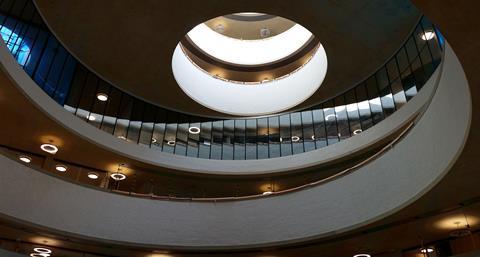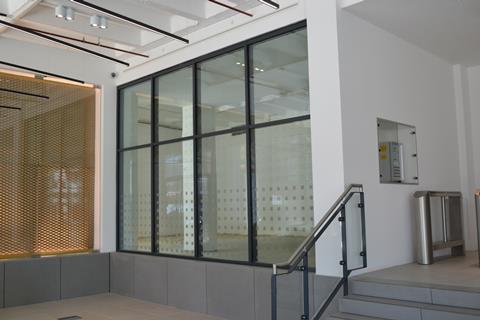Fire-resistant glass is an important requirement on many projects. This CPD, sponsored by Pyroguard, discusses the key considerations for specifiers

How to take this module
UBM’s CPD distance-learning programme is open to anyone seeking to develop their knowledge and skills. Each module also offers members of professional institutions an opportunity to earn between 30 and 90 minutes of credits towards their annual CPD requirement.
This article is accredited by the CPD Certification Service. To earn CPD credits, read the article and then click the link below to complete your details and answer the questions. You will receive your results instantly, and if all the questions are correctly answered, you will be able to download your CPD certificate straight away.
CPD CREDITS: 60 MINUTES
DEADLINE: 15 DECEMBER 2017

INTRODUCTION
Fire-resistant glass is manufactured in a number of different ways, depending on the required properties and performance level. This CPD discusses the different types, and the relevant standards and applications.
CLASSIFICATIONS
There are three available classifications for fire-resistant glass: integrity (E), radiation control (EW) and insulation (EI).
Integrity glass, E classification
This is the most basic type of fire resistant glass. When exposed to a fire, it prevents flames and hot gases from penetrating through to the unexposed side. It does not, however, stop heat from penetrating through the glass.
There are three methods of manufacture and finish for integrity glass:
- Wired glass: Wire is embedded into float glass while it is in a molten state. The glass is made in sheets, with a typical thickness of 6-7mm, and cut to size as needed.
- Modified toughened glass: A single pane of glass undergoes a toughening (or tempering) process, during which heat is applied in order to alter the structure of the glass and strengthen it. It is made to order and cannot be cut once it has been through the toughening process. This type of glass typically has a thickness of 5-12mm.
- Laminated glass: Two or more layers of glass are bonded together to form a laminated integrity glass, with a thickness of > 7mm. The glass is made in sheet form and cut to size.

Radiation control glass, EW classification
Like integrity glass, this classification of glass stops both flames and hot gases from penetrating through to the other side. It also prevents some heat from penetrating through, due to the way in which its interlayers react to fire.
According to BS EN 13501-2, the heat radiating through the glass should be no higher than 15kW/m2 when measured at a distance of 1m. As a guide, a normal house living room fire will radiate between 5-8kW/m2.
There are also three methods of manufacture for this type of glass:
- Coated modified toughened glass A special coating is applied to the outer layer of toughened glass to reflect some of the heat and therefore reduce the amount transferred through the glass. The glass is made to order and cannot be cut once put through the process.
- Laminated glass Two or more layers of glass with a resin or intumescent layer. The thickness of this type of glass varies by manufacturer, but is usually 7-20mm. The glass is produced in sheet form and cut to size.
- Gel-filled glass Two or more layers of glass with a fire resistant gel. The thickness of this type of glass can also vary, and is usually 13-20mm. The glass is made to order and cannot be cut.
Comparative testing of E and EW glass demonstrates how quickly radiant heat can cause items on the unexposed side to start smoking and then ignite. EW glass provides greater time for people to escape safely and for the fire brigade to access the area.

Integrity and insulation glass, EI classification
The EI classification is the highest of the fire-resistant glass classifications. When exposed to a fire, it prevents flames and hot gases from penetrating through, and also maintains the average temperature of the unexposed face to below 140°C. This must be specified for certain areas of buildings, according to Approved Document B of the Building Regulations, which covers fire safety (see below).
There are two methods for manufacturing this type of glass:
- The first consists of a multiple number of float glasses and silicate interlayers, with a total thickness between 15-50mm. Two versions of this glass are produced: one suitable for internal use, and one for use externally or within 2.5m of direct sunlight. This is because the silicate layer reacts to UV light, so in glass intended for external use a Polyvinyl Butyl (PVB) layer is included to prevent the reaction. The glass is produced in sheet form and cut to order.
- The second method consists of two or more panes of toughened glass and a clear fire-resisting gel interlayer. A spacer is installed around the perimeter edge of the glass with an edge seal capping to prevent leakage of the gel. In these products the thickness of the gel is usually greater than 3mm. The thickness varies between 18-55mm. This type of glass is UV stable so there is only one type suitable for all applications. It is made to order and cannot be cut once it has undergone the process.
Generally, the thicker the glass the longer its performance rating – for example, 30 minutes, 60 minutes or 90 minutes. Glass with an EI30 classification would be rated for 30 minutes.

RELEVANT STANDARDS
Building Regulations
Fire safety is covered by Approved Document B of the Building Regulations for England and Wales. This states where and at which levels of fire resistance products should be used throughout domestic buildings (volume 1) and commercial buildings (volume 2). However, in reality it provides only a guideline and is open to interpretation in many areas.
For buildings other than dwelling-houses, ratings of up to 180 minutes may be required depending on whether sprinklers are installed, the height of the building and the depth of the basement. It should be noted however that the operation of sprinklers can affect the performance of fire-resistant glass.
Approved Document K of the Building Regulations covers protection against falling, collision and impact. This identifies certain parts of internal and external walls as critical glazing locations, where the glass must be impact glass. Doors and side panels must be class 2 if the width is greater than 900mm, and class 3 if the width is more than 250mm and less than 900mm. If panes are of a thickness greater than 6mm, with a width less than 250mm and area less than 0.5m2, an impact rated glass is not required.
British and European standards
BS EN 1363 covers fire testing standards. All manufacturers should test their glass in accordance with this standard, to comply with UK regulations and the European requirement for CE marking.
BS EN 13501-2 defines the classifications of E, EW and EI fire glass. In some European countries, radiation control glass (EW) is the minimum standard for fire protection glass, but the UK Building Regulations do not yet acknowledge it, although it may be specified for certain applications. In some European countries, the use of integrity only glass (E) is restricted because it is considered less safe.
BS EN 12600 covers impact safety for glass in buildings, specifying a pendulum impact test method. This classifies flat glass products into three principal classes by performance under impact and by mode of breakage. Products are given a three-figure classification, consisting of a digit, a letter and another digit – for example, 1B1, 2B2 or 3B3.
These represent:
- the height from which a weight was dropped on to the glass and the glass passed the impact test. The first digit can be 1, 2 or 3, representing one of three measured heights: 1 = 1200mm, 2 = 450mm, 3 = 190mm.
- how the glass behaves when it eventually breaks. A = as annealed glass, B = as laminated glass, C = as toughened glass
- the height at which the glass does not break. For glasses A and B this will always be the same as the first number. Toughened glass is deemed to have passed the test if it has shattered into small particles.

ADDITIONAL FEATURES OF FIRE-RESISTANT GLASS
Fire glass has many additional features to provide other types of performance as well as fire protection.
Energy performance
Fire-resistant glass is available as single, double and triple-glazed units. Using a low-emissivity or solar-control counterpane can help to meet a specified energy performance criteria, as set out in Part L of the Building Regulations. Low g-values (solar energy transmittance of glass, also called a solar factor) can be achieved. U-values (efficiency of an insulating material) can be as low as 1.0W/m2 for double-glazed units or 0.6 W/m2 for triple-glazed units (centre pane value).
The glass specification can also earn credits under the BREEAM rating system in several categories:
- Energy: Combining fire glass with a low emissivity or solar control coated glass will help provide the building with good thermal performance and reduce energy consumption.
- Health and Well Being: Glazed elements in a building with a high light transmission enable a natural connection to the outside, helping to create better working, learning and living environments. Fire glass, whether single-glazed or in a constructed unit generally provides very good light transmission.
Acoustic properties
Multilayered fire glass can offer sound reduction of up to 47dB. Fire glass can be further laminated or used in double and triple glazing to increase the sound reduction to over 50dB. Acoustic calculations are available from manufacturers. This can help to meet Part E of the Building Regulations.
Flexibility
A range of decorative and horizontal applications are possible with fire-resistant glass, including frameless systems. Specification types include single frame, window, glazed screen, curtain wall, single door, double door, unequal double door and as a structural wall. Systems can be made from steel, timber or aluminium.

How to take this module
UBM’s CPD distance-learning programme is open to anyone seeking to develop their knowledge and skills. Each module also offers members of professional institutions an opportunity to earn between 30 and 90 minutes of credits towards their annual CPD requirement.
This article is accredited by the CPD Certification Service. To earn CPD credits, read the article and then click the link below to complete your details and answer the questions. You will receive your results instantly, and if all the questions are correctly answered, you will be able to download your CPD certificate straight away.
CPD CREDITS: 60 MINUTES
DEADLINE: 15 DECEMBER 2017
Privacy policy
Information you supply to UBM Information Ltd may be used for publication and also to provide you with information about our products or services in the form of direct marketing by email, telephone, fax or post. Information may also be made available to third parties. UBM Information Ltd may send updates about Building CPD and other relevant UBM products and services. By providing your email address you consent to being contacted by email by UBM Information Ltd or other third parties. If at any time you no longer wish to receive anything from UBM Information Ltd or to have your data made available to third parties, contact the Data Protection Coordinator, UBM Information Ltd, FREEPOST LON 15637, Tonbridge, TN9 1BR, Freephone 0800 279 0357 or email ubmidpa@ubm.com. View our full privacy policy at www.building.co.uk/cpd





























No comments yet